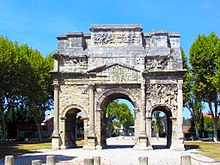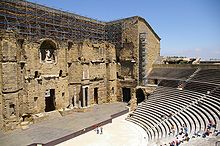Orange (Vaucluse)
| orange | ||
|---|---|---|

|
|
|
| region | Provence-Alpes-Cote d'Azur | |
| Department | Vaucluse | |
| Arrondissement | Carpentras | |
| Canton | Orange (main town) | |
| Community association | Pays Réuni d'Orange | |
| Coordinates | 44 ° 8 ' N , 4 ° 49' E | |
| height | 24-127 m | |
| surface | 74.20 km 2 | |
| Residents | 28,919 (January 1, 2017) | |
| Population density | 390 inhabitants / km 2 | |
| Post Code | 84100 | |
| INSEE code | 84087 | |
| Website | www.ville-orange.fr | |
 Orange - the Roman Theater in the middle |
||
Orange (Occitan Aurenja ) is a French city with 28,919 inhabitants (at January 1, 2017) in the Vaucluse department in the region of Provence-Alpes-Cote d'Azur . It is located on the River Eygues , which flows into the Rhone a few kilometers later .
history
The city's historical name was Arausio , after a local Ligurian-Celtic water god. The association with "orange" as color and fruit only came about later due to the increasing homophony .
In 105 BC The battle of Arausio took place between the Romans and the Cimbri and the Teutons . Thousands of Romans were killed. Orange was a diocese from 350 to 1801 . In 529 the Synod of Orange took place. In the 16th century, the city fell to the Dutch line of Nassau as the capital of the Principality of Orange , hence its nickname Nassau-Orange . In 1713 Orange came to France after the Treaty of Utrecht .
politics
Politically, Orange, like many places in the south of France, can be classified as conservative to nationalist. Since 1996, the right-wing extremist Front National has provided Jacques Bompard as the city's mayor. This was often used by the party as a "showcase" for campaigning. Bompard was re-elected in 2001 and 2008 with around 60% of the vote. In 2005 he joined the right-wing conservative Mouvement pour la France , in 2010 he founded his own party "Ligue du sud". For this reason, relations with the German twin cities of Rastatt and Dillenburg were frozen from 1996 to 2008 .
After the French parliamentary elections on June 18, 2017, Mayor Jacques Bompard will remain a member of the French National Assembly for another five years. As a candidate for the Ligue du Sud party, he was able to narrowly win the decisive second ballot in constituency 4 of the Vaucluse département with 50.37% of the vote. His challenger from the Macron party “ La République en Marche ”, Carole Normani , received 276 votes less and achieved 49.63% of the vote.
coat of arms
Description: In blue three golden oranges (2: 1 set) with green branches under a golden shield head with a blue horn on a red ribbon.
Development of the population
| year | 1962 | 1968 | 1975 | 1982 | 1990 | 1999 | 2008 |
|---|---|---|---|---|---|---|---|
| Residents | 19,912 | 24,562 | 25,371 | 26,499 | 26,964 | 27,989 | 29,527 |
| source | |||||||
Attractions
The city is known for a number of Roman buildings, in particular for the impressive theater and the “ city foundation arch ”, the construction of which began immediately before or during the reign of Emperor Augustus . In 1981, these buildings were by the UNESCO in the list of World Heritage added.
"City Foundation Arch"
On the road to Lyon there is a three- arched Roman monumental gate, which is often incorrectly referred to as a triumphal arch . With its length of 19 meters, a height of 18 meters and eight meters wide, it is considered one of the largest and best preserved of its time.
It was probably built between 10 and 20 AD and inscribed in 26/27 AD. The partially deciphered inscriptions indicate that the gate is a city arch. Originally there must have been a quadriga and bronze statues on the upper attic , which are no longer preserved today. A heavily eroded relief image shows a Gaul battle. Above the side gates a hodgepodge of warlike utensils is depicted: weapons, especially swords and shields with various decorations, lances, armor and parts of warships.
After the Counts of Baux converted the monument into a crenellated tower and reinforced it like a fortress in the 13th century, it was only restored to its present state in the 19th century.
Roman theater
Downtown Orange is home to the 1st century AD Roman theater, believed to be one of the best preserved in the world. For economic and static considerations, the theater was built on the slope of a hill. To do this, some corridors had to be cut directly into the rock.
With the fall of the Roman Empire, the construction shared the fate of many other ancient sites and was treated as a quarry. During the Middle Ages and well into modern times, many of the houses built in the area of the former theater formed a regular residential area of the city. During the French Revolution , parts of the theater were used as a prison, in which the enemies of the revolution were held under unworthy conditions.
It was not until 1824 that extensive renovation work began under the architect Auguste Caristie . Since 1869, regular performances and concerts have taken place in the "ancient" theater, including the so-called Chorégies d'Orange . Today the theater can seat around 7,000 people, a figure around 10,000 is assumed for Roman times. Only the first three of the original rows of seats have been preserved.
Fragments of the 3.55 m high emperor statue of Augustus have been restored - a replica of this original adorns today's scene wall of 103 m length and 38 m height. To the west of the theater are the ruins of a temple that was apparently dedicated to the deified Augustus.
More Attractions
- The former Notre-Dame cathedral from 1083 to 1126 and the town hall (Hôtel de Ville) from 1671. Both buildings are located in the old town north of the theater.
- Opposite the Roman Theater is the Musée d'Art et d'Histoire with ancient finds (including the three Roman land register plans from the last quarter of the 1st century) as well as paintings from the 17th to 20th centuries (including depictions of the India factory of the Swiss Jean Rodolphe Wetter , founded in 1757).
- From the hill of Colline St-Eutrope south of the Roman Theater there is a beautiful view of the city.
Town twinning
Orange has been related to the other Orange cities in Europe since 1964:
-
 Breda in Noord-Brabant (Netherlands)
Breda in Noord-Brabant (Netherlands) -
 Diest in Flanders (Belgium)
Diest in Flanders (Belgium) -
 Dillenburg in Hessen (Germany)
Dillenburg in Hessen (Germany)
and also with
-
 Byblos in Lebanon, since 2004
Byblos in Lebanon, since 2004 -
 Jarosław in Poland, since 2000
Jarosław in Poland, since 2000 -
 Kielce in Poland, since 1992
Kielce in Poland, since 1992 -
 Rastatt in Baden-Württemberg (Germany), since 1965
Rastatt in Baden-Württemberg (Germany), since 1965 -
 Spoleto in Umbria (Italy), since 1981
Spoleto in Umbria (Italy), since 1981 -
 Vélez-Rubio in Andalusia (Spain), since 2004
Vélez-Rubio in Andalusia (Spain), since 2004 -
 Vyškov in the Czech Republic, since 1964
Vyškov in the Czech Republic, since 1964 -
 Weifang in the People's Republic of China, since 2004
Weifang in the People's Republic of China, since 2004
Personalities
sons and daughters of the town
- Agénor Étienne de Gasparin (1810–1871), Reformed publicist and campaigner for religious freedom in France
- Camille du Locle (1832–1903), librettist
- Jean Echenoz (* 1947), writer
- Michel Petrucciani (1962-1999), jazz pianist
- Joris Chotard (* 2001), soccer player
People who worked in orange
- Martyrs of Orange , 32 women religious who were executed in Orange in 1794 and beatified in 1925
Web links
Footnotes
- ↑ https://www.jusos-rastatt.de/meldung/kritik-an-bompard-ist-keine-demokratienachhilfe/
- ↑ https://www.rastatt.de/index.php?id=4604
- ↑ INSEE ( Memento of the original from January 11, 2012 in the Internet Archive ) Info: The archive link was inserted automatically and has not yet been checked. Please check the original and archive link according to the instructions and then remove this notice. , accessed May 25, 2011



